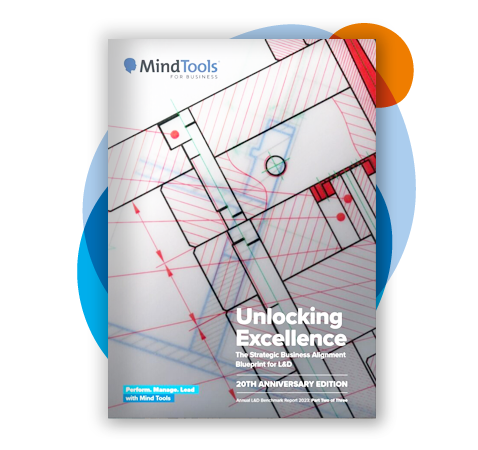Delve into the second installment of MindTools' "Annual L&D Benchmark Report 2023. This report, crafted from two decades of global research, delves into how learning and development (L&D) strategies can align with and propel business goals. It covers the influence of L&D on organizational performance, employee engagement, and the evolving demands of the business environment.

This resource is recommended for its educational value and is not an EDU Fellowship original work. All rights belong to the original creators. Credit: MindTools.
🚀 Actionable Insights: Gain access to specific, actionable insights and strategies derived from the report, enabling you to apply these learnings directly to your L&D initiatives.
🌟 Sarah's Transformational Journey: Dive into a detailed case study about how Sarah, an L&D professional, revolutionized her department using insights from the "Annual L&D Benchmark Report 2023: Part Two." Learn from her challenges, strategies, and triumphs.
📈 Data-Driven Approaches: Understand how to leverage data and analytics to enhance the effectiveness and ROI of your L&D initiatives.
Elevate your L&D expertise and become a strategic asset to your organization. Click here to unlock your Pro Member benefits and step into a world of advanced learning and development insights.
💡 The Big Ideas
Here's a concise summary of its key arguments and content:
Strategic Business Alignment: The report argues that L&D should not be seen as a standalone function but as an integral part of the overall business strategy. It emphasizes that L&D initiatives should align with the organization's goals and objectives. This alignment ensures that L&D contributes directly to business performance and is not just a peripheral activity.
The four stages discussed in the PDF:
- Stage 1: Doing a Lot but Achieving a Little: (51% of L&D teams surveyed are stuck here) - In this stage, L&D teams are highly active but lack synergy in their activities. There's a clear divide between behaviors they engage with consistently and those they engage with occasionally. The most powerful connections between behaviors are clustered around activities they're engaging with the least. Organizations in this stage often feel overwhelmed and underequipped (Page 13).
- Stage 2: Creating Space but Lacking Connection: As organizations move to stage 2, L&D teams gain clarity and reduce their activity significantly. They select a few important activities and do them well. However, there's a lack of interaction between the key practices of their model, leading to a skewed balance across activities (Page 14).
- Stage 3: Experimenting with New Ideas and Building Connections: In this stage, L&D teams actively experiment with new ideas and build meaningful connections between activities. They have created space and gained clarity, which allows them to see things more clearly and engage in more targeted and effective activities (Page 17).
- Stage 4: Linking Everything Back to the Business: In the final stage, L&D activity is high, similar to stage 1, but behaviors are well-connected and intentional. The focus is on strategic and business alignment, which forms the core of all L&D activities. This stage is characterized by a network where behaviors are carried out with a similar level of effort, and the practices are interconnected rather than isolated (Page 16).
Organizational Impact and Employee Engagement: A significant focus of the report is on how L&D influences organizational performance. It suggests that effective L&D practices lead to higher employee engagement, which in turn drives better business results. The report highlights the need for L&D teams to understand and respond to the changing dynamics of the workforce and the workplace.
Adaptability to Change: The report discusses how L&D teams have had to adapt during challenges such as the COVID-19 pandemic. It highlights the importance of flexibility and the ability to quickly respond to changing business needs and external factors.
Learning Maturity and Network Analysis: The report uses network analysis to study the relationship between different L&D behaviors and stages of learning maturity. This analysis helps in understanding which L&D practices are most effective and how they can be implemented in different organizational stages.
Defining Success in L&D: The report stresses the importance of defining clear success criteria for L&D initiatives. It argues that success in L&D should be measured not just by training completion rates or learner satisfaction but by how well it meets the strategic needs of the business and contributes to its objectives.
💭 Story Time: The Weaver and the Tapestry
In a quaint village, there lived a skilled weaver renowned for creating the most exquisite tapestries. Each tapestry was a complex blend of different threads, colors, and patterns, coming together to form a beautiful and coherent image. The weaver, with great care and attention, chose each thread according to the role it would play in the larger design.
This weaver's approach is a parable for effective Learning and Development (L&D) in an organization. Just as the weaver selects and weaves each thread to contribute to a greater design, an L&D professional must integrate various learning initiatives and strategies to form a cohesive and effective development program. Each thread in the tapestry represents different elements of L&D - from on-the-job training to formal education, and from e-learning to mentorship. The weaver's skill in bringing these elements together harmoniously mirrors the L&D's role in aligning learning strategies with the diverse needs and goals of the organization.
The beauty of the tapestry lies in how each thread, while distinct, contributes to a greater, more beautiful whole. Similarly, in an organization, the true value of L&D is realized when individual learning paths and organizational goals are woven together, creating a tapestry of growth, development, and success.
🎯 Insights & Action Steps
Action Steps:
- Align Learning with Business Strategy: Regularly review and align L&D activities with the organization's strategic goals.
- Engage with Business Leaders: Foster a collaborative relationship with business leaders to ensure L&D initiatives support overall business objectives.
- Measure Impact: Develop metrics to assess the impact of L&D activities on business outcomes.
Action Steps:
- Integrate Learning Activities: Design learning programs that integrate various activities, ensuring they support and build upon each other.
- Promote Collaborative Learning: Encourage collaborative learning experiences that foster connectivity among team members.
- Evaluate Learning Ecosystem: Regularly assess the learning ecosystem for gaps or overlaps in learning activities.
Action Steps:
- Stay Informed: Keep abreast of changes in the business environment and industry trends.
- Flexible Learning Strategies: Develop flexible learning strategies that can quickly adapt to changing needs.
- Continuous Improvement: Regularly review and update L&D programs to ensure they remain relevant and effective.
Action Steps:
- Scenario-Based Learning: Implement training that uses real-world scenarios and challenges.
- Hands-On Experience: Encourage learning through hands-on experiences and practical exercises.
- Feedback and Iteration: Gather feedback from learners and iterate on training programs to enhance their relevance and effectiveness.
Action Steps:
- Leverage Learning Analytics: Use data analytics tools to gain insights into learning patterns and effectiveness.
- Personalize Learning: Utilize data to personalize learning experiences based on individual needs and preferences.
- Data-Driven Decisions: Make informed decisions about L&D strategies based on data and analytics.
🌎 Case Study
🌟 Transforming L&D: Sarah Johnson's Strategic Shift at TechFront Innovations
The Unease at TechFront
TechFront Innovations, once a beacon of technological prowess, was facing an unsettling reality. The rapid evolution of the tech industry had left their L&D department in a state of disconnect. They were seen merely as training providers, detached from the strategic heartbeat of the company. In this climate of unease, Sarah Johnson, an insightful L&D professional, recognized the need for a profound transformation.
The Challenge:
TechFront's L&D department was stuck in a traditional role, disconnected from the strategic objectives of the company. This misalignment was becoming increasingly evident as the skills gap within the workforce widened.
Phase 1: Strategic Realignment
Objective: Elevate L&D from a training provider to a strategic partner within TechFront.
Sarah's Steps:
- Leadership Engagement: Sarah initiated crucial conversations with top management to understand the strategic direction of the company.
- Alignment Workshops: She organized workshops to align the L&D team's goals with the company's long-term vision.
- Data-Driven Approach: Utilized analytics to identify skill gaps and align training initiatives with business needs.
Breakthroughs:
- Established a clear connection between L&D initiatives and TechFront's strategic goals.
- Shifted the perception of L&D from a cost center to a strategic asset.
Phase 2: Redefining the L&D Program
Objective: Develop an L&D program that is strategically aligned and focused on real-world business impact.
Sarah's Strategic Actions:
- Curriculum Revamp: Overhauled the training curriculum to focus on skills that directly impacted business outcomes.
- Collaborative Learning Culture: Fostered a culture of collaborative learning, breaking down silos between departments.
- Integration of Real-World Projects: Linked learning initiatives with ongoing business projects for practical application.
Phase 3: Implementing the Strategic Vision
Objective: Implement the redefined L&D program, emphasizing its strategic importance.
Sarah's Implementation Plan:
- Strategic Communication: Communicated the new vision and role of L&D across the organization.
- Cross-Functional Learning Initiatives: Promoted cross-departmental learning projects to enhance collaboration.
- Continuous Feedback Loop: Established mechanisms for ongoing feedback to keep the program aligned with business objectives.
Phase 4: Solidifying L&D's Strategic Role
Objective: Cement the role of L&D as a strategic partner in the organization.
Sarah's Consolidation Efforts:
- Impact Measurement: Implemented tools to measure the direct impact of L&D initiatives on business performance.
- Stakeholder Reviews: Regularly reviewed the alignment of L&D activities with stakeholders to ensure continued relevance.
- Iterative Improvement: Continuously refined the L&D strategy based on feedback and business evolution.
Key Outcomes:
- A marked improvement in the alignment of skills development with TechFront's strategic goals.
- Recognition of L&D as a key player in driving business success.
- Enhanced employee engagement and skill application in real-world scenarios.
Conclusion:
Sarah Johnson's journey at TechFront Innovations is a testament to the transformative power of strategic alignment in L&D. By repositioning the L&D department from a peripheral training provider to a core strategic partner, Sarah not only bridged the skills gap but also played a pivotal role in steering the company towards a future of innovation and sustained growth.
Note: "TechFront Innovations" and "Sarah Johnson" are fictional entities created for this illustrative
👉 Steal This LinkedIn Post
Source link here: https://www.mindtools.com/business/research/unlocking-excellence
Copy and Paste
🌟 L&D's Strategic Evolution: Key Insights from the "Annual L&D Benchmark Report 2023"
Just finished the "Annual L&D Benchmark Report 2023: Part Two," and it's a game-changer for us in L&D. Here's a quick rundown of why this is a pivotal read:
Why This Matters: 🌍
As L&D pros, we're not just trainers; we're strategic architects shaping the skills and capabilities of our organizations.
Key Takeaways: 🚀
- Strategic Alignment: Align L&D with business goals. We're strategic assets, not just cost centers. 🎯
- Collaboration is Key: Break down learning silos. Foster a culture of collaborative and integrated learning. 🤝
- Adaptability: Stay agile and responsive to changing business needs. It's essential for relevance and effectiveness. 🌪️
- Practical Learning: Focus on real-world applications. The true value of L&D lies in practical skill application. 💼
- Data-Driven Decisions: Use data and analytics to shape and evaluate L&D initiatives for better ROI. 📊
- Personalization Matters: Tailor learning to individual needs. It's crucial in today's diverse work environment. 🌍
This report redefines our role in L&D. We're not just delivering training; we're aligning learning with strategic business objectives and driving impactful change. Let's embrace these insights and lead the transformation!
#LearningAndDevelopment #StrategicAlignment #FutureOfWork #DataDrivenLearning
🧠 Key Terms Discussed
Organizational Learning Index
- Definition: A metric or set of metrics used to gauge the learning and development maturity of an organization.
- Relevance: Helps in benchmarking the organization's L&D effectiveness against industry standards.
- Examples: Assessments of learning culture, technology adoption in learning, employee skill development.
- Related Terms: Learning maturity model, benchmarking.
- Common Misconceptions: Believed to be solely focused on formal training metrics.
Strategic and Business Alignment
- Definition: The process of aligning L&D strategies with the overall business objectives of an organization.
- Relevance: Ensures that L&D initiatives contribute to the company's success and ROI.
- Examples: Tailoring training programs to meet business goals, aligning employee development with company objectives.
- Related Terms: Business strategy, organizational goals.
- Common Misconceptions: Sometimes seen as the sole responsibility of business leaders.
L&D Team Capabilities
- Definition: The skills and competencies of the L&D team in an organization.
- Relevance: Determines the effectiveness of L&D initiatives and their alignment with organizational goals.
- Examples: Skills in instructional design, training delivery, performance consulting.
- Related Terms: Talent development, team competency.
- Common Misconceptions: Often thought to be limited to training delivery.
Employee Experience
- Definition: The journey an employee takes within an organization, including all interactions and experiences.
- Relevance: Impacts employee retention, job satisfaction, and productivity.
- Examples: Onboarding process, training programs, workplace environment.
- Related Terms: Employee journey, employee satisfaction.
- Common Misconceptions: Sometimes reduced to just HR policies or benefits.




